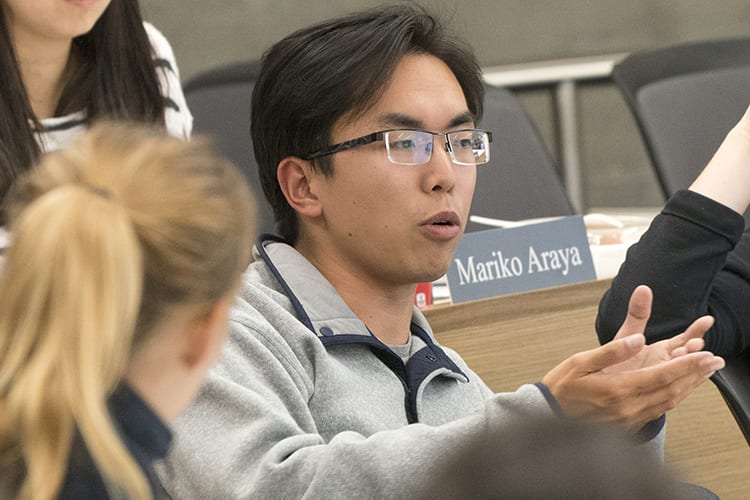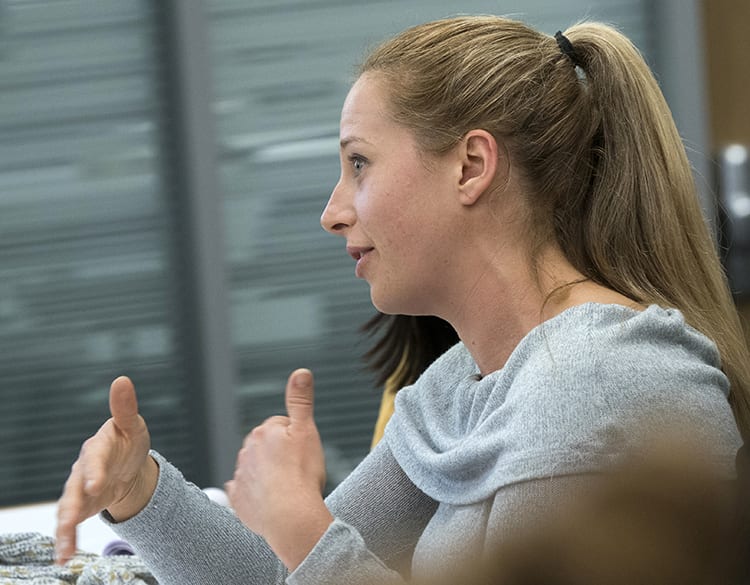Tag: Social Impact
A handout or a helping hand? How we judge others guides how we help others
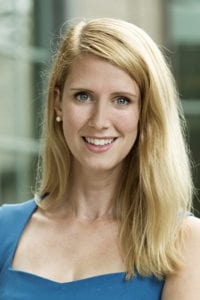 Charities often emphasize the desperation and dependence of those they assist—as in heart-tugging videos of starving children in Africa. Yet a focus on helplessness may change how we choose to help those in need, and not necessarily for the better, according to research by Berkeley Haas Asst. Prof. Juliana Schroeder.
Charities often emphasize the desperation and dependence of those they assist—as in heart-tugging videos of starving children in Africa. Yet a focus on helplessness may change how we choose to help those in need, and not necessarily for the better, according to research by Berkeley Haas Asst. Prof. Juliana Schroeder.
“Charities want to motivate people to give more, but they may also make people think poor people don’t have the ability to take care of themselves,” says Schroeder, a social psychologist who studies judgment and decision-making as well as interpersonal and intergroup processes. “If you perceive of someone as having less mental capacity to think or feel, then you are subtly degrading and dehumanizing them.”
In a study published in the Journal of Experimental Psychology, Schroeder and co-authors Adam Waytz of Northwestern University and Nicholas Epley of the University of Chicago found that people act more paternalistically towards those they believe have lower mental capacity. What’s more, they found, people often believe they have more mental capacity than do others.
Their findings reveal fundamental truths about how people think about giving and receiving aid. These insights have implications not just for international charity, but also for policies on a wide range of issues, from soda taxes to gun control.
 Paternalistic aid
Paternalistic aid
Schroeder and her colleagues conducted a series of nine experiments, making a distinction between paternalistic aid, in which givers make a decision about what recipients need, and agentic aid, in which recipients can decide for themselves what they need.
In the first experiment, they asked people to rate their perceptions of poor people in Kenya and Uganda, using an eight-point scale that measured perceived self-control, memory, planning, thoughtfulness, and cognition. They then asked subjects to decide whether they’d rather contribute to a charity called GiveDirectly, a relatively agentic charity which transfers money to poor people with no strings attached, or to a more traditional, paternalistic charity such as the Red Cross, which provides food, medicine, and other services.
They found that those who rated the mental capacity of the African aid recipients more highly were also more likely to choose GiveDirectly, and less likely to believe the recipients would waste the money. “When you think of a person having less self-control and willpower, you think they will make bad decisions and will be more likely to waste the aid,” says Schroeder. “They don’t know what is good for themselves.”
(Schroeder’s study didn’t examine which charity was actually more effective, focusing rather on which charity people thought would be better. However, a controlled experiment by Princeton professors Johannes Haushofer and Jeremy Shapiro found no evidence that recipients of GiveDirectly’s unconditional cash transfers waste the money; rather, the cash transfers measurably increase food security and economic and psychological well-being. A group of researchers, including Berkeley’s Michael Walker and Ted Miguel, are currently conducting a larger study on the program.)
Helplessness vs entrepreneurial spirit
Moreover, the researchers found that people’s ideas about aid recipients’ mental capacity could be easily manipulated. In another experiment, they gave more than 500 visitors to Chicago’s Museum of Science and Industry a token representing a dollar, and then asked them to drop it in one of two slots—one for GiveDirectly and the other for OxFam, a more paternalistic global charity that seeks to alleviate poverty.
Beforehand, they gave participants one of two descriptions about charity recipients: one highlighted their drive and entrepreneurial spirit; the other, their neediness and resignation. While overall, 58 percent of participants gave to OxFam versus 42 percent to GiveDirectly, those who were told of the recipients’ pluck were 23 percent more likely to choose GiveDirectly. “Even when the recipient group is exactly the same, the information you give someone about them meaningfully influences their giving behavior,” Schroeder says.
Different rules for ourselves
Schroeder and colleagues also found that when it comes to themselves, however, people tend to prefer a more hands-off approach. In another set of experiments, they presented participants with a series of policies on issues including healthy eating, credit card debt, retirement savings, and gun control. They then asked them whether a paternalistic or agentic policy would be more effective for the average citizen, as well as which policy would be more effective for themselves.
Participants were much more likely to choose the paternalistic policy for others. For example, 35 percent recommended a ban on unhealthy foods over a policy of listing calories in restaurants for others, whereas only 28 percent recommended it for themselves. Likewise, 55 percent recommended mandatory retirement accounts rather than optional accounts for others, versus 39 percent for themselves. A similar 55 percent recommended bans on certain firearms over a gun safety course for others, but only 39 percent for themselves.
Using statistical analysis, the researchers found that the results were largely determined by how people rated others’ mental capacities versus their own. “People are pretty convinced they have a lot of willpower, while others don’t have the same level of self-control,” Schroeder says.
Thinking twice about assumptions
In yet another experiment, however, researchers found this assumption too is changeable. The day before Thanksgiving, the researchers asked participants whether they had high willpower; they then asked a different group of people the same question the day after Thanksgiving—presumably after they’d had one or two extra helpings of turkey and apple pie. The second group not only rated themselves as having lower willpower, but they were also more open to paternalistic policies on healthy eating, both for themselves and others.
Schroeder points to the fact that such perceptions are malleable as a good reason to question how our perceptions of ourselves and others may affect the way we behave. Charities that emphasize the helplessness of aid recipients may unintentionally send a signal they have low mental capacity. “When you dehumanize an individual or a group it can affect how you help them,” Schroeder says.
Meanwhile, those donating to charities or setting policies for fellow citizens may want to think twice about the assumptions they are bringing to their own altruistic impulses, and what is most likely to empower those they seek to help. “People can be more cognizant about the ways they are thinking about their own mental capacity and that of others,” says Schroeder, “and pause to get more information before they start helping.”
More research by Asst. Prof. Juliana Schroeder:
 Donald or Hillary? Why listening to them matters to voters.
Donald or Hillary? Why listening to them matters to voters.
MBA seminar builds skills to talk about race and racism
When Anne Kramer, MBA 18, attended the first session of a new seminar called “Dialogues on Race,” she was surprised to learn she’d spend the initial two weeks in a group with other white students. They were asked to discuss the first time they realized they were white, past experiences talking about race, and hopes and concerns for the class—before coming back together with the diverse class group.
“It felt weird and uncomfortable (for students to be divided up by race), but it made it very real,” Kramer said. “We were there not to ignore differences, but to understand differences and then have a dialogue about them.”
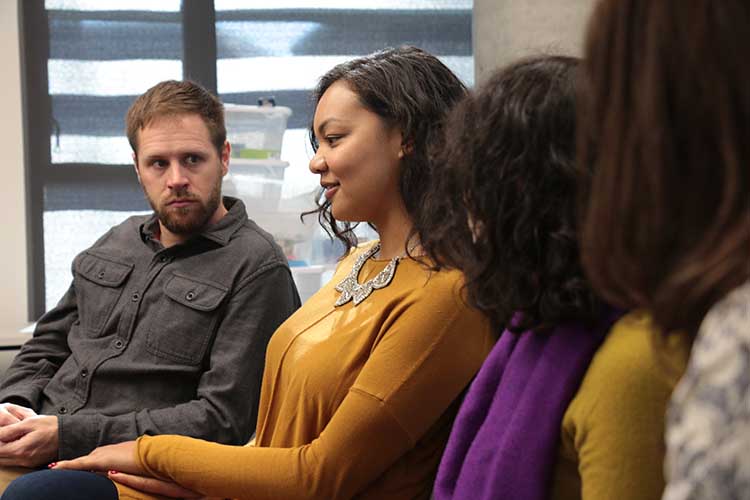
Reflecting on identity and power
Bringing that discomfort into the open was exactly the point of the student-led independent study seminar, launched this fall in the Full-time MBA Program. A survey led by MBA students in the Race Inclusion Initiative last year found that while 90 percent of their classmates believe that understanding racial dynamics is a key component of effective leadership, less than half say they are comfortable talking about race.
Inspired by a class called “Diversity in the Workplace,” Liz Koenig, MBA 18, drafted a plan to push classroom discussions on race even further. That became “Dialogues on Race,” a ten-week seminar aimed at creating a safe space for students to develop better skills for engaging in these conversations in their careers and lives.
“The ability to reflect on identity and power is a core competency, certainly for being a leader of any kind, or a manager of human beings,” said Koenig.
Pete Johnson, Assistant Dean for the Full-time MBA Program & Admissions, said the seminar builds on elective MBA courses such as “Diversity in the Workplace,” “Groups and Teams,” and “Business Case for Investing in Women,” which all explore ways to understand diversity and help students to develop management skills. Berkeley MBA students can develop student-initiated or independent study courses under the guidance of a faculty advisor.
“I’m thrilled that our students are using the independent study option to further enhance their ability to lead diverse teams and organizations,” Johnson said.
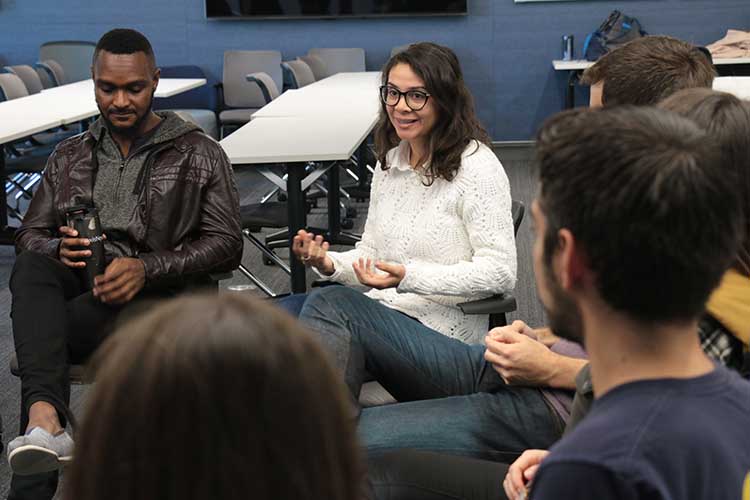
Balancing the class
Koenig and co-facilitator Om Chitale, also MBA 18, actively recruited a broad cross-section of students, and chose the class times based on when the most representative groups were able to enroll. There was so much interest that they added a second section, facilitated by Atim Okorn, MBA 18, and alum Patrick Ford, MBA 17, who had co-led the Manbassadors male ally program as a student. Asst. Prof. Drew Jacoby-Senghor acted as faculty sponsor.
In the end, the classes included about 60 percent white students and 40 percent students of color—a ratio similar to the racial and ethnic breakdown of the US population. Aside from two students with scheduling conflicts, all 28 students who applied were able to enroll.
“We didn’t want to end up in a situation where there was anyone who felt like they had to speak for a group,” said Koenig.
Erin Gums, MBA 18, said she enrolled because she realized she had a part to play in the conversation. Growing up identifying as both black and Pacific Islander, and working for years in education, she had thought about and talked about race her entire life—but was not having those conversations with her white peers, she said. This was a group she trusted enough to open the conversation.
“This experience was something I will always remember as a very important part of my time here at Haas,” said Gums, who also serves as VP of Diversity for the MBA Association. “I have chosen to be in the business world and be a business leader, and I have chosen to play a role in pushing for a less racist society. This course helped me put words to some ideas that I’d never articulated clearly, and to practice skills to have these sensitive conversations with people in less comfortable environments in the future.”
Burning questions
According to Chitale, the class took on a life of its own. As students provided feedback from week to week, the facilitators adjusted the course content and structure—for instance, by replacing one of the final sessions with an open two-hour discussion of “burning questions.”
“One thing that was interesting was how the goals of the class evolved,” said Adrian Williams, MBA 18. “At first it was giving people practical, tactical tools on how to attack issues of diversity and inclusion outside of the classroom. Over time, we realized some of the issues were a lot more nuanced than we thought. It also became apparent that I had some blind spots that required me to think through some of my arguments.”
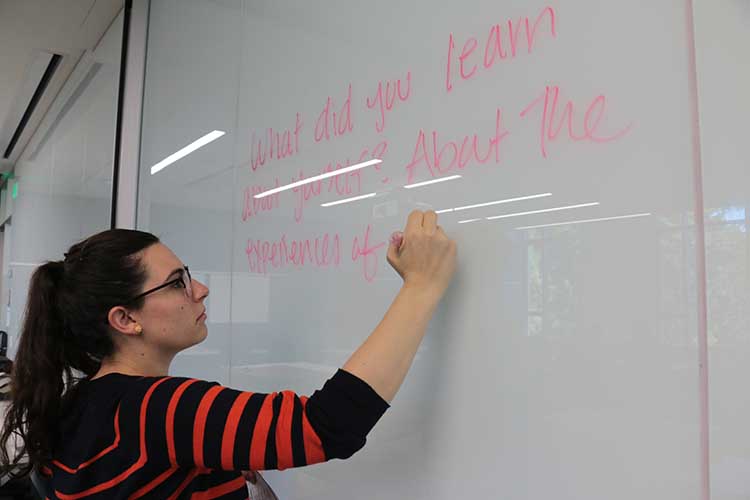
For Kramer, this class was the first opportunity she’d had to engage in deliberate conversations on race. “The concept of race in the US was something that I didn’t see in my everyday life growing up,” said Kramer, who spent much of her childhood in London and Hong Kong. “Conversations that I might have shied away from before, or uncomfortable things that people might have said before, now I’m willing to actually ask: ‘What makes you think that?’”
Kim Ayers, MBA 18, said it was eye-opening to learn that her classmates of color were dealing with hurtful interactions related to their race on a regular basis. “The fact that I was largely blind to that until we directly engaged in this conversation was really powerful to me,” said Ayers.
Awkward and intense moments
Gums said there were some awkward and intense moments—which she believes are inevitable for change to occur. “My fluency with these topics is going to be greater than that of people who have just started thinking about these issues for the first time in their lives, and that’s okay,” she said. “We need to recognize that people will mess up and say the wrong thing, but that shouldn’t prevent you from continuing to have these difficult conversations.”
Ultimately, “issues of race and racism are so complex and messy—there’s no one approach or one good way to solve it. If it were that simple we would have figured it out by now,” Gums said. “There are many roles we need people to play to address systemic issues.”
The course is one of several student-led initiatives aimed at helping students develop more fluency in addressing racial dynamics. Students in the Race Inclusion Initiative—a research-based MBA student effort to increase the number of underrepresented minorities in the program and make the climate welcoming for all—organized “Dialogues over Dinner” this month, where students were asked to read an article or watch a short video on a race-related topic and then discuss it over small group dinners. All ten of the dinners were facilitated by students from “Dialogues on Race” eager to put their learning into practice.
Koenig and her co-facilitators are planning to lead “Dialogues on Race” again in the spring. It garnered rave reviews, and they’ve received over 47 applications for the spring section. “My hope is that we get to a place where this is considered core to the fabric of any MBA program,” she said.
“Businesses have power and influence in society,” said Chitale, the co-facilitator. “If we can get business leaders to be open and vulnerable on ideas of identity and power and privilege, I truly believe that’s going to have an impact on society.”
Patrick Awuah, MBA 99, founder of Ashesi University, receives WISE Prize for Education
Watch a documentary of 2017 WISE Prize for Education recipient Patrick Awuah, MBA 99, founder and president of Ashesi University in Ghana.
Her Highness Sheikha Moza bint Nasser, chairperson of Qatar Foundation, presented the prize to Awuah on Nov. 15 at the Opening Plenary session of the 8th World Innovation Summit for Education in Doha, Qatar, before an audience of 2,000 people from 100 countries.
New Center for Gender, Equity & Leadership to launch at Haas
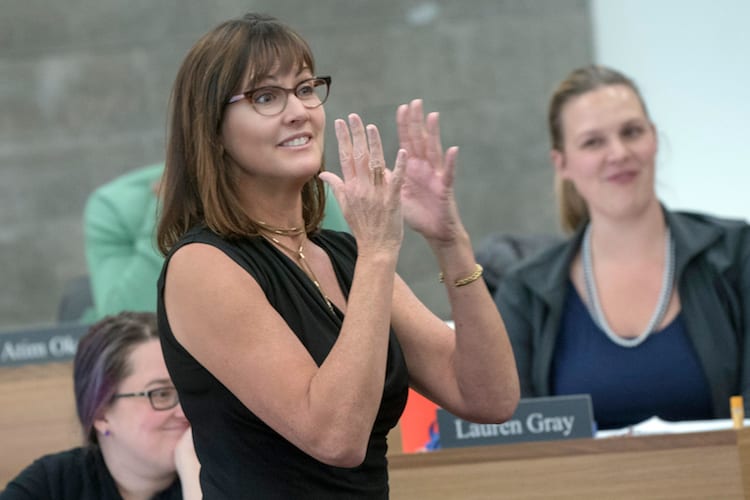
Kellie McElhaney has for years built the case that when businesses fail to diversity their leadership, or don’t treat men and women equally, they risk their bottom line. Now, she’s launching a breakthrough new center to put that data—as well as the deep Haas faculty research expertise—to work.
“The economic case for supporting workplace diversity and women in business has never been stronger,” said McElhaney, an associate adjunct professor at Haas, who is launching the new Center for Gender, Equity & Leadership (CGEL) on Nov. 6. “Women, underrepresented minorities, and the LGBTQ community face systemic structural, cultural, and individual barriers to opportunities and advancement. We will work to identify and tackle these problems and develop an evidence-based playbook.”
The center’s goals include bringing leaders from diverse political and corporate backgrounds together to discuss advancing gender and diversity in policy and business; engaging male and female allies and uniting people at the intersection of all ethnicities, races, and classes around a shared goal of gender and diversity equity; and developing leaders who understand that gender is a spectrum, not a binary construct.
Four alumni who are active in gender and equity leadership will speak at the launch event: Larissa Roesch, MBA 97, vice president and portfolio manager at Dodge & Cox; Nikita Mitchell, MBA 15, founder of Above the Bottom Line & senior manager of strategy & planning at Cisco; Kate Morris, MBA 14 lead, people & inclusion at Adobe; Brandon Doll, MBA 14, vice president, strategy and business development for the Oakland Raiders. (RSVP for the launch event here)
Tapping Haas faculty research expertise
McElhaney’s leadership team includes Prof. Laura Kray, who studies gender stereotyping and negotiations, and Prof. Laura Tyson, faculty director of the Institute for Business & Social Impact, who has written extensively about how gender equality worldwide is associated with better education and health, higher per capita income, faster and more inclusive growth, and greater international competitiveness.
While the center will support and explore new research, existing research by Haas faculty members runs deep.
McElhaney, who currently teaches a course called “The Business Case for Investing in Women,” conducted 2016 research with Genevieve Smith on the zero percent pay gap between men and women at the Gap, Inc. Meantime, research by Prof. Clayton Critcher detailed the multiple negative consequences of concealing one’s sexual orientation at work; Kray’s recent work outlined how fixed beliefs about gender roles preserve the status quo; and Prof. Jennifer Chatman detailed how political correctness in the workplace encourages men and women to be more creative by reducing uncertainty in relationships.
Moving the needle
McElhaney came up with the idea for the center four years ago, and raised funds with the encouragement of Dean Rich Lyons. “I started doing research on what other schools were doing, and what we could do to truly move the needle and be disruptive,” she said. “While other schools are focusing more on diversity or counting the heads, we are focused comprehensively on inclusion in our classrooms—through our cases, our choice of course speakers, our faculty teaching methodology, and our student culture.”
McElhaney’s successful campaign led to $1.6 million in donations, including a founding corporate gift from the Gap Foundation.
CGEL has no shortage of timely issues to focus on, from pay inequity to maternity leave to the continued low representation of women in leadership roles—not to mention the daily headlines revealing the latest sexual harassment accusations in the business world. Only 5.6 percent of CEOs at S&P 500 companies are women (and as of March 2017, only two were women of color). Women account for only 20 percent of board seats and 20 percent of C-suite positions in these companies.
“The majority of CEOs include gender equity among their Top 10 priorities, yet boardrooms and C-suites are not changing quickly enough,” Lyons said. “While the commitment to diversity and an inclusive work environment is there, too few have a handle on solutions. Our new center will work toward immediate change in these areas and pave the way for future generations.”
Jamie Breen, assistant dean of the MBA program for working professionals at Haas and a CGEL founding advisory council member, said she’d like to know why the drop-off rate for women on the path to upper leadership tracks increases significantly at the VP to SVP level.
“We used to think that getting women into very senior leadership positions was a pipeline issue—if we got women into the pipeline, it would take care of itself,” she said. “We now know that is not the case. We have systemic issues, and we need to understand the unwritten rules and practices that drive these outcomes and, more importantly, how to make them explicit and change them.”
To help make these changes, the center will invite corporate leaders for round table discussions, sponsor new research, work with teams of student consultants on real-world business challenges or case competitions, place faculty as conference speakers, and provide scholarships/fellowships.
Classified: The slam-dunk case for investing in women in business
“Classified” is an occasional series spotlighting some of the more powerful lessons being taught in classrooms around Haas.
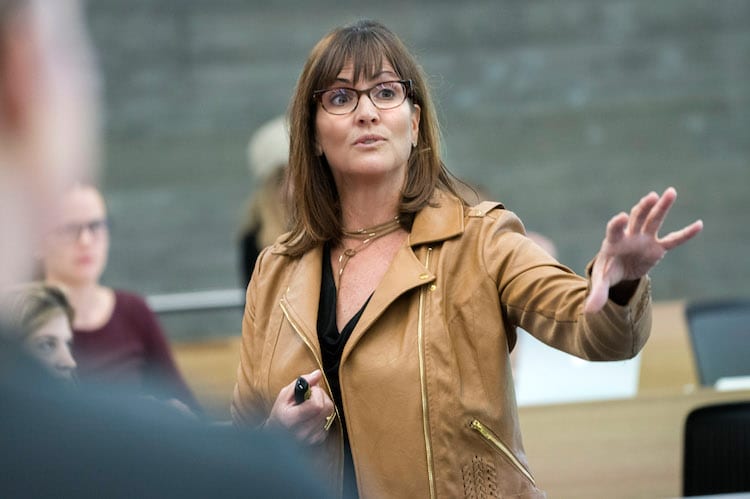
Class discussions about sex trafficking, crash test dummies designed to match male—but not female—physiology, and the challenges a breast pump company faced in attracting venture capital were unsettling.
But it wasn’t until the conversation turned to the relatively mundane acts of sexism women encounter daily—such as unwanted advances at business dinners—that Federico Locatelli, MBA 18, spoke up.
“I didn’t really understand before what women have to deal with,” said Locatelli, one of the ten men in Kellie McElhaney’s class “The Business Case for Investing in Women.” “It’s been completely mind-blowing.”
For McElhaney, an associate adjunct professor who created the course four years ago, Locatelli’s discomfort isn’t a reason to stop the conversation, but rather a justification to blow it wide open.
“This is about pushing people out of their comfort zones so that they can then become leaders who can handle uncomfortable discussions later on,” McElhaney said.
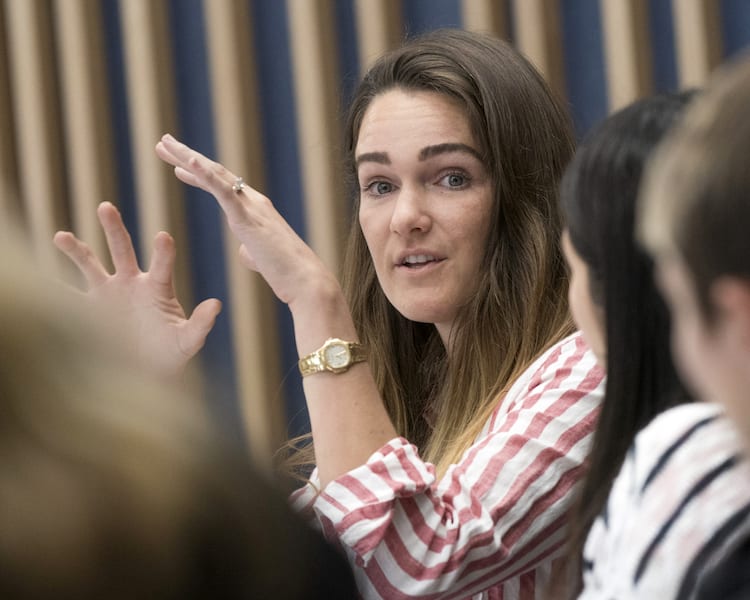
Building a case
The idea for an MBA course focused on gender equity first came to McElhaney about a decade ago while she was serving as director of the Center for Responsible Business at Haas. McElhaney had uncovered a correlation between Fortune 500 companies’ performance on a closely-watched sustainability index and the presence of women directors on its board. That data point alone suggested there was a business case—not just an ethical one—for gender diversity in the workplace.
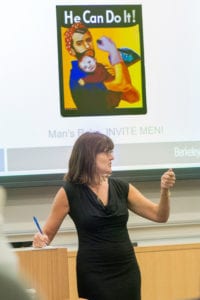 Over the next few years, as the cultural conversation around women at work gathered momentum, companies started asking McElhaney for more proof of a bottom-line payoff to hiring women.
Over the next few years, as the cultural conversation around women at work gathered momentum, companies started asking McElhaney for more proof of a bottom-line payoff to hiring women.
Students, too, wanted to see data. “In a very constructive way, students would say, ‘Show me the proof that gender equity really matters to a company’s overall success.’”
So, McElhaney gathered statistics which suggested companies with greater numbers of women in leadership have higher share prices and better returns on equity and investment than companies with fewer women. She cites companies like Patagonia, which has publicly detailed how its on-site childcare nearly pays for itself.
When McElhaney started the course in 2013, she structured it almost entirely around the data. The class proved so popular that students awarded her an Earl F. Cheit Award for Excellence in Teaching. Next month, McElhaney is also launching the Center on Gender, Equity & Leadership to take her work to the next level.
“Kellie is a firecracker—passionate, smart, challenging, and funny,” says Jennifer Hoss, MBA 18. “She takes a very pragmatic approach of ‘nobody is asking for any favors.’ At the same time, this class is a great exercise in empathy.”
Hoss said she enjoyed seeing the diversity of opinions, even among women. “You realize that each person experiences gender issues in a different way. We have 30 different women and 30 different viewpoints on how wrong or not-wrong a situation is,” she said.
Exploring intersectionality
The course also delves into the added challenges that minority women encounter. McElhaney shared a breakdown of data showing that white women are making most of the workplace gains while minority groups either are flat-lining or losing ground.
Victoria Whittaker, MBA 18, who is African-American and Latina, said that when it comes to gender, race, and sexuality, “we tend to separate the issues.”
Shedding light on the intersectionality of an issue like gender helps raise awareness that there can many different experiences and perceptions that influence people’s world views, she said. “As business leaders and managers, it’s imperative that we start to recognize, think about, and appreciate all the different facets people bring when they walk into the workplace,” she said.
Are diversity and inclusion valued?
Many of McElhaney’s students, including Locatelli, are intent on using their newfound awareness to advocate for women. “Students—and this is also true for the companies I talk to—understand the data,” McElhaney said. “Now they want tools to create change.”
One assignment McElhaney gives students is to write formal assessments of a company’s track record on the hiring, retention, and promotion of women. The head of global HR at Airbnb was so impressed with a student presentation—which McElhaney sent unsolicited—that she asked the students to speak to company executives about it.
Students also discuss real-life workplace issues with guest speakers.
In October, a speaker admitted how shocked he was when a valued female executive at his company disclosed in her exit interview that she didn’t feel as though diversity and inclusion were valued. Looking to uncover insights like these sooner, he instituted “stay” interviews for current employees.
Designing a personal leadership strategy
McElhaney also challenges students to consider their own experiences with gender discrimination or harassment, including how they’ve responded to past incidents and how they could have reacted differently. For a session that delved into how men impact gender issues, students were required to bring a male friend to observe the class.
Finally, students create a detailed personal leadership strategy.
“You’re at Haas to learn about business strategy,” McElhaney tells students. “You’re also here to learn leadership skills. So, how are you going to build gender awareness into your leadership style?”
Lydia Cole, EWMBA 18, came to the class looking for facts and figures to help her self-advocate in her career. She’s learned instead that proof of women’s value in the workplace won’t be as important as her ability to lead by example.
“My attitude before was cynical,” said Cole. “Kellie’s class has taught me how to be a better employee, a better manager, a better leader, and a better person.”
Berkeley Board Fellows program: training students to dive deep on boards
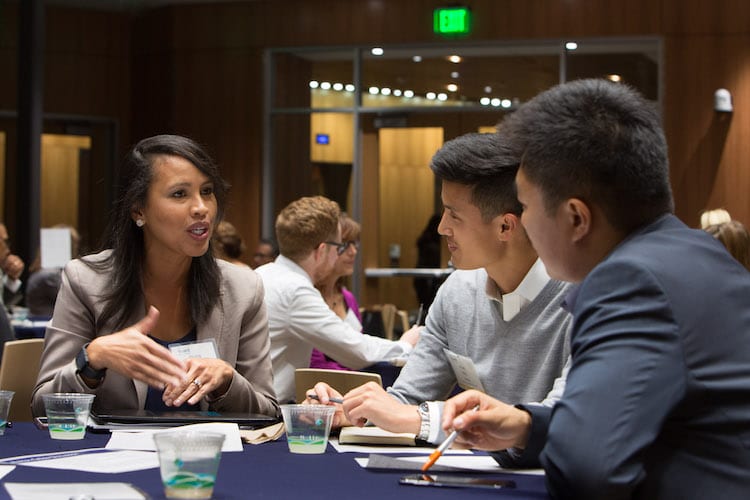
The Berkeley Community Fund’s Joleen Ruffin chats with board fellows Ryan King and Justin Zhang, both MBA 19s.
As a rising executive at education nonprofit 114th Partnership, Laura Hassner, EMBA 18, found a perfect opportunity to gain a deeper understanding of how boards work as a Berkeley Board Fellow.
“This program is a natural fit, as it provides a professional opportunity to support a board and a way to become a better board member myself,” said Hassner, who is working with the board of 10,000 Degrees, which helps students from low-income backgrounds to complete higher education. “I’ve already been able to apply my classroom learning in real time and I’m able to do it to help underrepresented kids succeed in college.”
Hassner, who is a president of her EMBA class, is one of 70 Berkeley graduate students who will serve on nonprofit boards of directors this fall as part of the program, which is operated by the Haas School’s Center for Social Sector Leadership. Founded in 2003, the program has placed a total of 875 fellows on nonprofit boards.
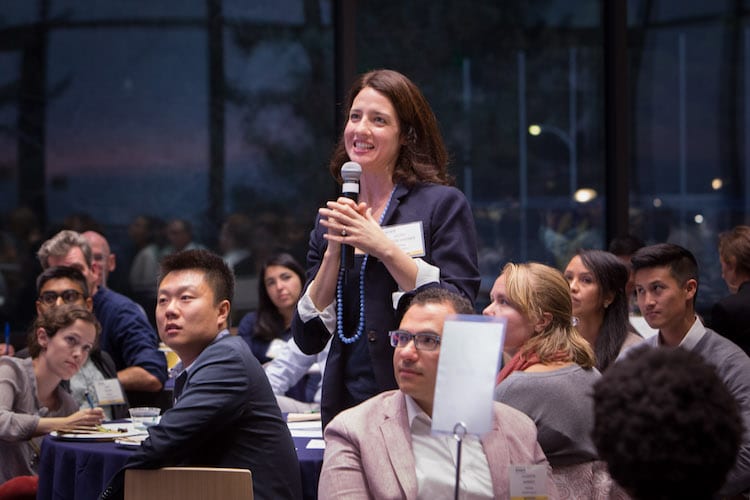
The fellows—which this year include 30 students from the full-time MBA program, six from the evening & weekend program, and five students from the executive MBA program—will volunteer on the boards of 35 Bay Area nonprofits.
Students were introduced to their boards at an Oct. 11 event, attended by Dean Rich Lyons. Organizations participating this year include The Bread Project, Freight & Salvage, Destiny Arts Center, Meals on Wheels of Alameda County, The Jewish Community Center of the East Bay, the East Bay College Fund, the Alameda Point Collaborative, Mission Neighborhood Centers, and Goodwill.
“We’re so excited to launch our 2017 group of fellows into the nonprofit community,” said Ben Mangan, executive director of the Center for Social Sector Leadership. “Collectively, our fellows have had such a positive impact on Bay Area boards through their work—and our nonprofit partners, in turn, have provided an invaluable educational resource to our students.”
Projects that create change
Board fellows receive training at Haas, attend board meetings, and spend about eight hours per month completing a project requested by the boards. This year, Ryan King and Justin Zhang, both MBA 19s, (in top photo with Joleen Ruffin) have been asked by the Berkeley Community Fund‘s (BCF) board to work on a project to evaluate the best practices of career development support services for first-generation college students at organizations similar to BCF’s—and to recommend a framework to establish a similar program.
“Justin and Ryan will find out about the resources available that we can tap into or identify what we can develop ourselves,” said Joleen Ruffin, executive director of the Berkeley Community Fund, which provides support and college scholarships to Berkeley public high school graduates.
This project builds on the 2016 student project that explored the effectiveness of relationships between community mentors and BCF’s scholars. These relationships often weakened over the course of four years, Ruffin said, and the board fellows, through interviews and working with the board, found out why—and identified ways to help the mentors feel more useful to the students and the students to feel more supported. “We started to implement solutions right away which was fantastic,” Ruffin said.
Learning from their “fellow fellows”
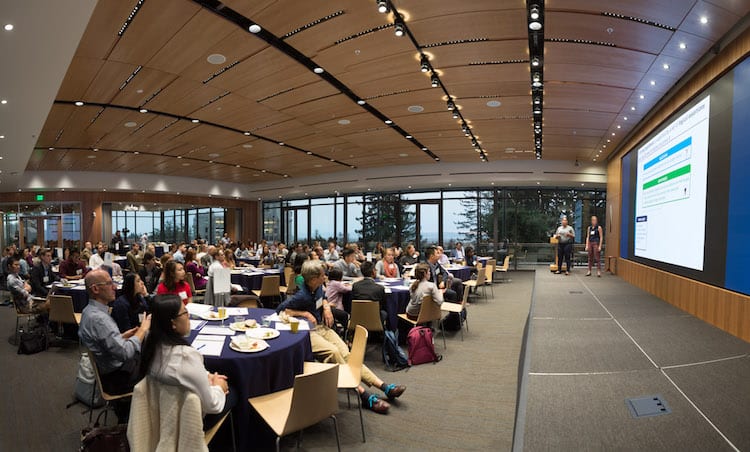
For many nonprofits and students, the program offers the opportunity to gain a deeper understanding of board governance and build relationships that continue after the projects are done. It also opens the door for fellows, to serve on boards in the future.
“Every year most fellows tell us they are likely to join a nonprofit board within five years,” said Cathy Garza, program director with the Center for Social Sector Leadership. “It’s my goal and hope that the program continues to seed the world with knowledgeable board members who will make a measurable difference in the world through board service.”
Oseyi Ikuenobe, MBA 15 and a product manager at Square, is a former fellow who is now a full Berkeley Community Fund board member. Tyler Swain, MBA/MPH 18, also a former fellow, serves on the board of the Huckleberry Youth Programs.
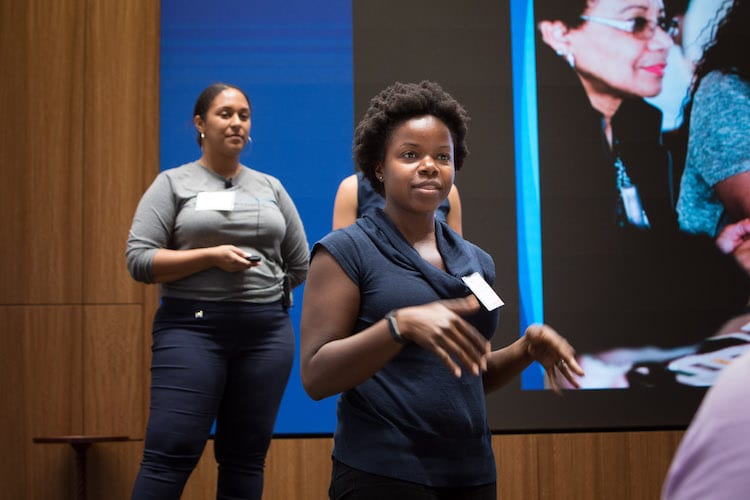
One change to the program this year is the hiring of a new staff program fellow, whose role is to build community and provide mentoring to the group of fellows.
“We received feedback that the students wanted to learn more from their fellow fellows,” said Kate Chadwick, a program manager in the Center for Social Sector Leadership. “They wanted to know more about the projects that other students were working on and how their boards worked, because every nonprofit board experience is different.”
Mary Ellen Harty, MBA 18, will serve in that role. Harty completed the program last year and returned because she wanted to help improve it. “I felt there was opportunity for the fellows to connect more outside of the kick-off and finale session, and leverage each other’s strengths and experiences,” she said. Harty will host office hours and brown bag lunches, and has created a Slack channel and Facebook group for the fellows.
On the ground in Greece, MBA students test tech to help refugees
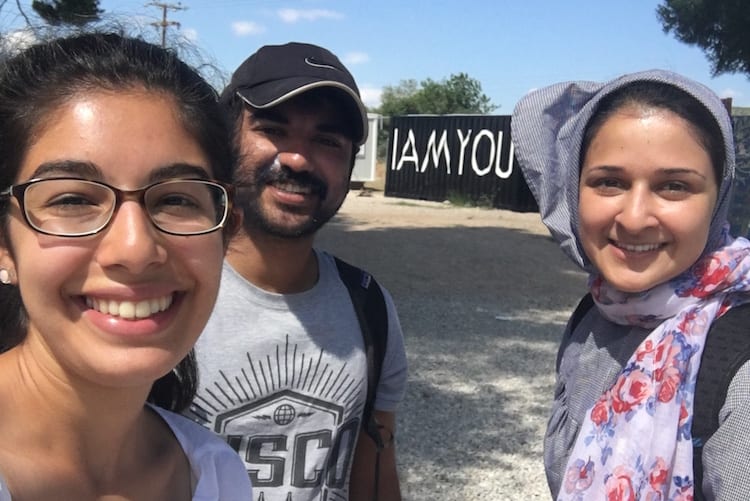
(Note: The first names of the refugees mentioned in this article have been changed to protect their privacy.)
In the sweltering June heat inside a refugee camp on the Greek mainland, Sarrah Nomanbhoy, MBA 18, listened closely as Khadija and her teenage son Tariq answered her questions about their family’s refugee odyssey.
Khadija’s family fled Syria’s civil war in 2015, heading for Turkey. A year later, they hired a smuggler who took them across channel to the Greek island of Chios in an overcrowded dinghy. They’d hoped to reach an uncle in Germany within three days by traveling through the Balkans, but found the borders had closed. Tariq searched his smartphone to figure out what to do next, but found that the information from humanitarian agencies too general, and that social media was filled with unverified rumors.
“They’ve now been waiting in Greece for over a year and a half,” Nomanbhoy said.
Nomanbhoy is not naïve enough to think that technology could remove the obstacles and traumas that this family and millions of other refugees on the move are facing. But she was there in the camp to find out whether she and her team—working on a startup called MarHub—could build a tool that could help refugees navigate the grueling asylum process.
“Lots of people have shown up in Greece with the ‘next app’ so there is a lot of skepticism,” says Nomanbhoy, a Silicon Valley native whose parents are both immigrants. “Refugees aren’t using these apps. We want to build something they will use.”
Over two weeks, three members of the MarHub team—which included Jerry Philip, EWMBA 19, and intern Ramah Awad—conducted interviews and tested their prototype with refugees in Athens, Ritsona, and in the Souda camp on the island of Chios.
Interviewing refugees
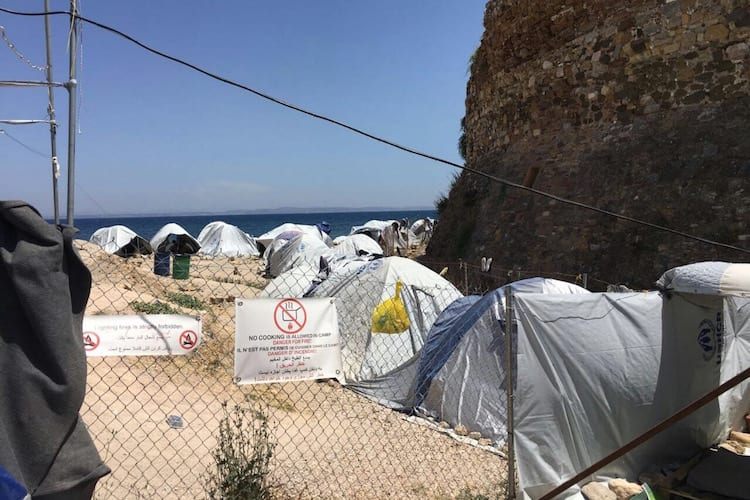
In interviews, the asylum seekers, many Syrian, but also Afghan, Pakistani, Nigerian and Moroccan, discussed the most challenging and uncertain aspects of the asylum process. Many shared that they were ill-prepared for the unexpectedly grueling asylum interviews. They were also largely unaware of their legal rights during the interviews, including the option to replace a translator or to review the interview transcript for inaccuracies. About 70% of asylum seekers receive negative decisions after this first set of interviews, and many are now in limbo pending the outcome of the appeal process, Nomanbhoy said.
Many face dire living conditions, violence within the camps, and racism from the local residents. “Witnessing the level of racism that asylum seekers are facing on a regular basis was really shocking,” says Nomanbhoy, recalling a few incidents where her team and asylum seekers they were interviewing were kicked out of local cafes on Chios.
Using iPads, the team showed refugees a prototype of the chatbot they developed, the first phase of MarHub’s crowdsourced information platform.
The chatbot allows a refugee to type questions through Facebook messenger and receive automated answers related to their asylum process based on where they are from, where they landed, and what their legal information needs are.
Creating a powerful tool
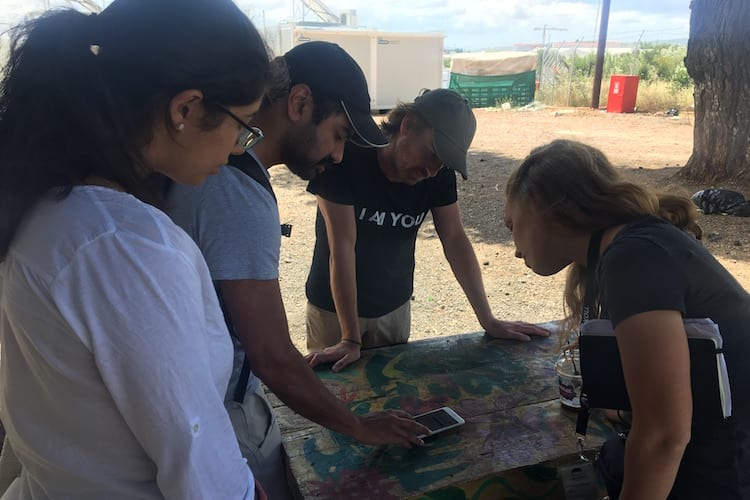
It also enables them to connect to legal aid volunteers for additional assistance. As more refugees use the chatbot, the data collected will enable more accurate, timely responses, Nomanbhoy said. It is this crowdsourced information that will give the tool its power.
“Our goal is to help refugees feel informed and help them prepare for their asylum interviews,” said Philip, a product marketing manager at Cisco who grew up in Abu Dhabi and India and moved to the U.S. a decade ago. Philip says he and the rest of the team have all experienced the limbo of visa applications and understand the pain points and the tedious aspect of waiting. “The hard part psychologically is not knowing how long the wait is going to be. Time moves very slowly when you’re waiting in a queue, but imagine not knowing whether you’ll be stuck for two months or two years.”
For Nomanbhoy, MarHub is a passion project that evolved from her interest in international migration. Growing up in the Bay Area, she saw immigrants driving entrepreneurship and making lasting contributions to the economy.
Before arriving at Haas, she launched a seed accelerator for startups in Sri Lanka and worked on a social enterprise to help migrant workers in Thailand send money home. Returning for an MBA was about getting the tools to start a company that could help change the way international migration is managed.
MarHub evolved from last year’s prestigious Hult Prize Challenge on Refugees. Nomanbhoy heard about the $1 million contest on a Friday night in November. By Monday she had met her co-founders—Philip; Peter Wasserman, MBA/MPH 18; and Srinivas Vaidyanathan, EWMBA 18. They put together their pitch within a week. After edging out 50,000 entrants, the team made it to the last round of the competition’s regional finals. Encouragement from judges, support from their advisors, Assoc. Adj. Prof. Thomas Lee and UC Berkeley Law Prof. Katerina Linos, along with a $5,000 Dean’s Seed Fund grant and the $5,000 Hansoo Lee Fellowship, helped the foursome launch MarHub. Nomanbhoy also won a $12,500 Jack Larson Scholarship, enabling her to work full-time on MarHub over the summer.
The chatbot’s usefulness expands
After seeing MarHub’s prototype, many of the refugees asked the team how to sign up for the service. “The work feels really urgent now,” said Nomanbhoy.
The team expects to roll out a pilot service in partnership with Greece-based organization RefuComm in the fall and then go on to raise seed funding. The Haas students on the team have chosen courses this year—including Descriptive & Predictive Data Mining, Startup Sales, and Lean Product Management—to align with the needs of their startup, which they hope to work on full-time after graduation.
While MarHub is now limited to the public Facebook site and the chatbot, the team is building an interactive mobile platform that will enable refugees to view, evaluate, and comment on information from humanitarian agencies, volunteers on the ground, and other asylum seekers.
Nomanbhoy said she sees the company moving from helping people navigate the interview appointment and asylum system to a long-term goal of using data to help improve migration management.
Lee, who teaches Product Design at Berkeley-Haas, praised the team for taking what they learned in class and applying it in Greece. “I think there’s a stereotype about the Bay Area that we’re solving first-world problems for the millennials, but the real issue is the next billion users, and, in some sense, that’s what Sarrah’s team is focused on,” he said. “They really got their hands dirty and went to these refugee camps to get a sense of the real problems for refugees. They’re applying lessons from class to understand those problems.”
— Krysten Crawford contributed to this story.
Berkeley-Haas Names First Winner of New Investment for Impact Prize
Job applicants will accept lower wages in order to work for a socially responsible employer, according to research by the winner of the newly launched Investment for Impact Research Prize.
Berkeley-Haas created the prize last year to encourage new academic research on the social and environmental effects of capital investment.
The competition drew a total of 48 papers. A team of 11 judges from the academic, investment, and nonprofit world selected the winners.
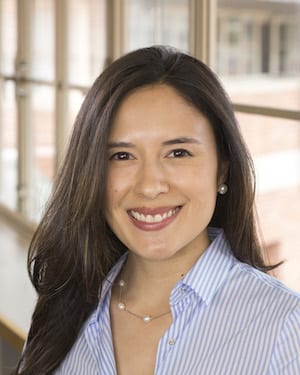
The first-prize winner, Vanessa Burbano, an assistant professor of management at Columbia Business School, won for her paper, Social Responsibility Messages and Worker Wage Requirements: Field Experimental Evidence from Online Labor Marketplaces.
“This paper is important because it speaks to a transition we’re seeing in the labor market,” said Adair Morse, the award’s faculty co-director (with Assoc. Prof. Ayako Yasuda of the UC Davis Graduate School of Management) and an associate professor of finance at Berkeley-Haas. “It shows that the social–plus-economic agenda, as opposed to a purely-profit agenda, can be a powerful way to understand individuals’ decision-making.”
The winning paper presents the results of two experiments in which workers applied for short-term jobs online and, in some cases, were given information about the employer’s charitable giving. In the first experiment, this information prompted applicants to accept slightly lower payments on average, with the highest performing workers responding most strongly.
In the second experiment, prospective workers submitted 44% lower bids for payment after getting information about the employer’s philanthropy. Burbano described the study as one of the first to show that social responsibility messages prompt workers to accept lower compensation. In the case of corporate social responsibility and wages, it’s hard to demonstrate cause and effect, she noted. “But, by using online labor markets, we have a clean causal story.”
Using capital for public good
The new award was created when Haas alumnus Allan Spivack, MBA 80, and CEO of RGI Home, offered last year to help the school finance a social impact research prize.
The Center for Responsible Business at Berkeley-Haas focused the prize on research into ways that capital can be used for public good, including social entrepreneurship and sustainable capital investment. The award complements Haas’s Moskowitz Prize, which concentrates on social responsibility at traditional investment funds.
“We award these prizes because Berkeley has always been a thought-leader in this space,” Morse said. “Thus, we at Berkeley-Haas want to continue to encourage rigorous scientific studies of how social agendas matter in broader contexts of economics, finance, law, management, or other social sciences.”
Two teams were awarded second prize, including Alexander Dyck of the University of Toronto, Karl Lins of the University of Utah; Lukas Roth of the University of Alberta; and Hannes Wagner of Italy’s Bocconi University, who found that institutional investors from countries with strong social responsibility values significantly influence the social and environmental performance of the companies they own. Caroline Flammer of Boston University, Bryan Hong of Ontario’s Western University; and Dylan Minor of Northwestern University showed that linking executive pay to a company’s social and environmental performance creates benefits ranging from lower carbon emissions to greater stock market value.
Berkeley-Haas MBA Students Work to Unite Youth Cyclists
Across the country, scores of youth cycling organizations are working separately on the same big goal: to get more kids safely riding bikes. How much more effective could they be if they had a way to pool resources and work together?
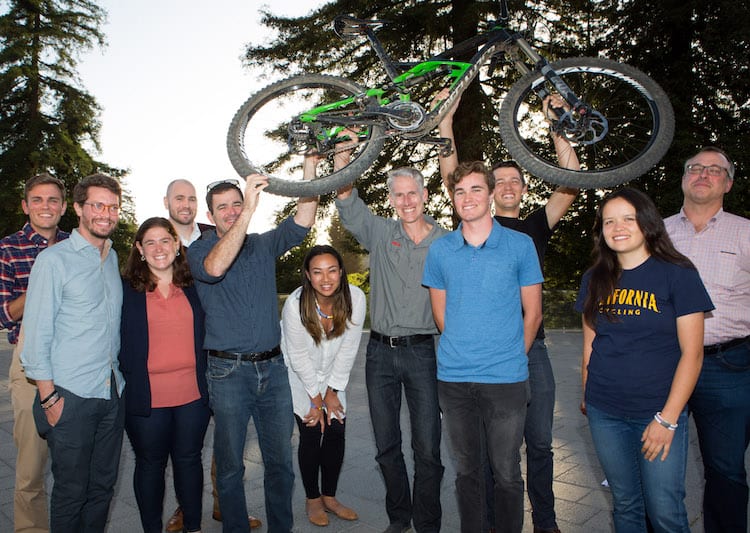
That was the vision that the Youth Cycling Alliance (YCA) brought to Berkeley MBA students in the Social Sector Solutions (S3) course in spring 2017. It was a daunting task that would involve compiling information on the country’s 12.5 million young riders, creating a national database, and developing common best practices to unite the disparate groups.

“I was pushed out of my comfort zone,” said Peter Severson, MBA 18, who served as team lead on the project. “Too often leadership opportunities are in title only. But in this role, I was pushed to design and execute a work plan for our team, partner with our nonprofit client, and resolve conflicts as they arose throughout the semester.”
The S3 course, co-taught by Adj. Prof. Nora Silver, faculty director of the Center for Social Sector Leadership at Berkeley-Haas, and Adjunct Prof. Paul Jansen, a former director at McKinsey & Co., is designed to solve problems for nonprofit clients. It brings together diverse teams of students–typically three MBAs, one student from another graduate program, and an undergraduate.
Past clients have included the Golden Gate National Recreation Area, the Berkeley Food Institute, and the Cool Climate Network.
This year’s project emerged after 11 youth cycling organizations from across the country met in Las Vegas last September, discussing how they could work more closely and effectively together to get more kids on bikes. While cycling is the most popular outdoor recreational activity in the US, only 24 percent of kids aged 6 to 17 participate, according to a 2016 Outdoor Industry Association report.
Out of the Las Vega meeting, the groups formed the Youth Cycling Alliance (YCA), with an aim to get more kids on bikes.
Customizing the model
The S3 project called for market analysis and interviews with cycling organizations and chapters. The first phase was research-heavy, involving a lot of internet searching, report reading, and deep-dive interviews with the 11 national youth cycling organizations, about everything from their struggles to meet program demands and provide experienced youth coaches to how to track success metrics of their programs for potential funders.
The second phase was forward-looking, as the team mapped recommendations for the group’s new network. Models for nonprofit networks are new and evolving. Nahry Tak, MBA 18, said she researched what nonprofits in the conservation space were doing, and also interviewed and read existing research from both Silver and Haas Senior Fellow Jane Wei-Skillern. “You don’t want to copy others,” Tak said. “You want to learn from the best practices of others and then customize your model and shape it.”
The students concluded that YCA needed to align on a shared vision, establish a culture of trust, and form immediate partnerships. They recommended six “quick wins” to immediately get more involvement in youth cycling.
For Severson, the project was socially and professionally worthwhile. “Through our successes and failures, I forged skills that I will employ throughout my career in whichever direction it takes me,” he said.
In addition to Severson and Tak, the team included Kyle Koning, and Federico Picca, both MBA 18, and Amy Traver, MBA/MPH 18.
Students Focus on Better Farming Methods in Patagonia Case Competition

Ali Ticker and Olga Ballard, both MBA 18, took the stage at the Patagonia Case Competition last Friday, pitching the judges a land-financing idea for the outdoor apparel company’s sustainable food division.
Their target was Patagonia Provisions, which sells responsibly sourced food and drink, such as ale made from a grain planted to reduce erosion and jerky made from bison whose grazing is helping to restore the prairie. Their idea was for the company to create or invest in a real estate investment trust that would encourage farmers to shift from conventional to regenerative and organic agriculture (ROA) methods that bring soil back to health after years of heavy pesticide and fertilizer use.
“It’s a solution that will scale,” said Ticker, who shared the stage with fellow Team Greenscape members Ballard, Adrian Lu, PhD 18, Ryan Peterson, MDP (Master of Development Practice) 18, and Michael Fleischmann, MPP 18. The group was among 10 finalist graduate school teams—culled from a total of more than 70 teams—selected to pitch last week at Berkeley-Haas.
Patagonia leaders joined forces with Berkeley-Haas last year on the case competition, which grew out of a conversation between the company and Robert Strand, executive director of the Center for Responsible Business at Berkeley-Haas.
“The goal is to take our most intractable environmental problems and bring them to the best young minds in the world,” said Patagonia CEO Rose Marcario, who also served as an event judge. “We have real business problems and we use this work and we put it into action.”
“Patagonia demonstrates such leadership by putting its greatest sustainability challenges out there in the open and humbly asking for help,” Strand said. “The sustainability challenges we face are simply too big for any single company to effectively address alone. It takes confidence without attitude to acknowledge this and open oneself up as Patagonia has.”

Last year’s competition focused on finding an alternative to widely used but potentially toxic poly-fluorinated chemicals (PFCs) which apparel makers add to their water repellant gear and clothing.
The winning University of Michigan team pitched an entirely plant-based nontoxic solution composed of materials from soy beans, potatoes, rice and corn, called the ‘SoyShield.’ Patagonia connected the team to the company’s material innovation engineers and Beyond Surface Technologies, one of Patagonia’s venture portfolio companies, to work on developing SoyShield. Phil Graves, managing director of Tin Shed Ventures, Patagonia’s venture capital arm, said the goal is to understand whether SoyShield will be commercially and technically viable.
This year’s case is a nod to Patagonia founder Yvon Chouinard’s focus on the critical role that food will play in solving the world’s environmental crisis. In the 25-minute documentary “Unbroken Ground,” the company argues that the vast majority of our food is produced using methods that reduce biodiversity, decimate soil, and contribute to climate change.
Competing teams in this year’s agriculture case competition pitched a variety of ideas, from scholarships for the children of farming families to mobile apps for farm expense tracking. Aside from UC Berkeley, competing teams included Yale, Cornell, Harvard, Babson, University of Virginia, MIT, University of Pennsylvania, Columbia, and the University of Michigan.

The 2017 winning teams included:
Yale’s Plant Power Team (first place): Plant Power offered regenerative recommendations to optimize soil quality management from Oregon to Iowa. The plan included health metrics and benchmarks, and addressed both cost and cultural barriers to adopting these practices. The team also recommended forming a network of ambassadors to evangelize regenerative practices.
UPenn’s (Re)Generation Y Team (second place): The team proposed Field ExChange, a mobile learning exchange that would provide a checklist to guide farmers through the steps to shift to regenerative farming. A financial and environmental impact calculator would help farmers develop business plans with financial projections; and a social network would connect key partners and promote information sharing.
MIT’s FARM Fair Agriculture and Resource Management Team (third place): Team FARM recommended a scholars-and-research fellows program for small family farmers and their communities. Other ideas included purchasing farm equipment to be shared in pilot community programs, and growing the company’s network through a new mail delivery service (like Blue Apron) and dinner parties.
The top three teams won a trip to Patagonia headquarters in Ventura, Calif., to present their proposals and—as a bonus—to do some surfing with Patagonia employees.
Three Berkeley-Haas Social Impact Startups Take Top Honors at LAUNCH
Three Berkeley-Haas teams focused on social impact took top honors at the recent finals of LAUNCH—University of California, Berkeley’s, Startup Accelerator and competition.
Taking advantage of the program’s new social track, the teams, LiftEd, Butterfly Medical, and Dost, participated in LAUNCH’s intensive three-month accelerator before going on to win the grand prize, second place, and second place (social category) awards, respectively. The third-place winner, Players’ Lounge, has Berkeley-Haas connections.
Now in its 18th year, the LAUNCH competition attracted close to 150 entries that were narrowed down to 19 teams, all of which participated in Demo Day on April 28.
The event, organized by Berkeley MBA students and sponsored by the Berkeley-Haas Entrepreneurship Program, included a startup showcase expo, keynote speeches from high-profile LAUNCH alumni, and fast-paced final pitches in front of judges, VCs, and an audience of more than 300 people. A total of five winners took home a total of $85,000 in cash and prizes.
The top three winners joined three other social impact startups in a new LAUNCH accelerator specially designed for social enterprises, which includes the Social Lean LaunchPad course taught by Jorge Calderon, a lecturer in the Haas Entrepreneurship Group.
Last week’s LAUNCH Demo Day included keynotes from previous competition winners: Brett Wilson, cofounder and CEO of TubeMogul, and MBA 07, and Nick Sturiale, Managing Partner at Ignition Partners, founding CEO of Timbre Technology, and MBA00.
The Winners
Grand Prize ($30,000 plus $15,000 in legal services from WilmerHale): LiftEd, which makes an iPad application that helps education professionals accurately measure and reliably report the progress of special education students. There are nearly seven million pre-K to grade 12 students in the U.S. with legally diagnosed disabilities. LiftED enables educators to personalize student learning goals, analyze learning trends to make real-time adjustment to teaching methods, and share progress with school districts and parents. The team includes co-founder and CEO Andrew Hill and Amy Chou, both MBA 16. LiftEd also took first place in the “Information Technology for Society” category and second place in the “Campus & Community Impact” category on grand prize pitch day at the 2016 Big Ideas competition earlier this month.
Second Prize ($15,000): Butterfly Medical, which has developed an implantable device for the treatment of Benign Prostatic Hyperplasia (BPH), the non-cancerous enlargement of the prostate, which the company says affects 50 percent of men over age 60. The team includes CEO Idan Geva, MBA 09.
Second Prize (Social) ($15,000): Dost, which built a mobile phone platform that helps break the cycle of illiteracy by delivering early education content and activities to low-income moms. Dost was also a finalist in the 2016 Global Social Venture Competition. The team (in photo, left) includes Founder and CEO Sneha Sheth, MBA 16; Sindhuja Jeyabal, MIMS 16, I School; and Devanshi Unadkat, PhD candidate, UC Berkeley Graduate School of Education. Dost was also a category winner at the 2016 Big Ideas competition. (“Mobiles for Reading” category).
Audience Choice ($5,000): Innovein, which provides a prosthetic valve for the veins that helps cure venous leg ulcers, a condition that affects roughly four million people in the United States.
Third Prize (six months of free work space at WeWork): Players’ Lounge, a social video gaming startup that provides gamers with a platform to play their favorite sports games for cash and prizes. The team includes co-founder and CFO Mark Murphy, MBA 17.
Classified: Measuring the Effectiveness of Nonprofit Programs
By Charlie Cooper
In our ongoing series of “Classified” articles we spotlight some of the powerful lessons being taught in classrooms around Haas.
 MBA students enrolled in the Social Impact Metrics course at Haas spent the fall semester wrestling with a challenge that’s puzzled management experts for decades: How do you go about measuring the effectiveness of a nonprofit program?
MBA students enrolled in the Social Impact Metrics course at Haas spent the fall semester wrestling with a challenge that’s puzzled management experts for decades: How do you go about measuring the effectiveness of a nonprofit program?
In an era of algorithms and analytics, where almost anything can be measured, there’s a growing push for metrics that will help donors know whether programs are effective—and whether they’re getting their money’s worth.
To get a better idea of what works and what doesn’t, the Center for Social Sector Leadership at Haas formed a multi-year partnership with Amgen. The partnership centers on an interdisciplinary, graduate-level Social Impact Metrics course on measuring outcomes of cancer patient advocacy education and support programs.
“I want our students to be savvy about the claims that organizations make, and to be able to separate what is really working within the nonprofit sector from activities that may feel good but aren’t having much real impact,” said Lecturer Colin Boyle, (pictured), who teaches the course and also serves as deputy director of UCSF Global Health Sciences.
Amgen awarded $35,000 each to four cancer patient advocacy groups participating in the project—Bladder Cancer Advocacy Network, Cancer Support Community, Chris4Life Colon Cancer Foundation and Critical Mass.
In the class, 28 students broke into four teams that worked with the nonprofits to study the specific metrics challenges they faced. The goal was to come up with a plan of action by the end of the semester, when the class presented recommendations to their clients: four cancer patient advocacy education and support programs.
During the semester, the students evaluated the methodologies that the nonprofits might use to vet a program’s effectiveness. They also worked to identify signs that a program was succeeding or veering off track.
Many of the nonprofits were offering the same services—peer counseling, help lines, and webinars to educate people. But as Boyle noted, they weren’t learning from each other about how to do this more effectively. The course presented a new opportunity to foster greater sharing of best practices within the nonprofit community, he said.
“If everyone has a different help line, then let’s learn from each other so that we can do it as successfully as we can,” Boyle said.
Brigid Warmerdam, MBA 16, worked with the Cancer Support Community, a non-profit that operates a cancer support helpline focused on improving the livelihood of cancer patients and their families.
Her group was charged with making recommendations on how to best measure the helpline’s impact. At the end of the course, they recommended that the non-profit differentiate callers based on their reason for the call— for information, logistics, or emotional support —and to ask callers if their needs were met. The nonprofit could then use aggregate data to inform their program changes.
Warmerdam, who is a vice president at Wells Fargo, took the class hoping to learn more about measuring shifts in attitudes and behaviors, so she could apply this to both her job and her activist work. (One of her initiatives as a diversity leader was to launch a company-wide outreach program to engage LGBT team members with LGBT “allies” to promote diversity at the company).
“Measuring impact is a big challenge and the skills required are not obvious,” she says. “You need be a good listener, get comfortable with ambiguity, and work as a team. To me, this is the solution to doing the best job for your client.”
Chelsea Samuel, a master’s candidate at the Goldman School of Public Policy, who worked with Warmerdam on the project, said the course allowed them to apply principles from class in a real world setting, “with real constraints on their personnel and resources.”
“It was also fascinating to see how they intended to use the metrics,” she said.
Students who worked with the Bladder Cancer Advocacy Network came up with an entirely new approach for the non-profit, centered on the impact of bladder cancer treatments on sexuality.
The data the students gathered is also valuable for grant-pitching purposes, said Stephanie Chisolm, director of education and research for the Bethesda, Md organization.
“When we go to our partners in the pharmaceutical industry, they want a good estimate of whether what we’re doing will have an impact, and to know that we’re going to be able to report the results,” Chisolm said. “Ratcheting up our metrics is going be a huge benefit.”
Scott Heimlich, vice president of the Amgen Foundation, said many non-profits lack the resources to collect this sort of data.
“Our hope is that this work will go toward helping all patient advocacy organizations measure their effectiveness, and to help the larger nonprofit sector do what it does better,” he said.
When Commercial and Social Goals Merge in One Company: It’s a Hybrid!
 Outdoor clothing retailer Patagonia, footwear company TOMS, and organic yogurt maker Stonyfield Farm are among an emerging new class of “hybrid” companies that pursue social missions while relying on a commercial business model.
Outdoor clothing retailer Patagonia, footwear company TOMS, and organic yogurt maker Stonyfield Farm are among an emerging new class of “hybrid” companies that pursue social missions while relying on a commercial business model.
Although these hybrids bear strong promise, they are also fragile organizations that walk a fine line between achieving social goals and market requirements, according to authors of the Spring 2015 special issue of the California Management Review (CMR).
This new issue is one of the most comprehensive collections of research ever published on the emerging hybrid model.
The issue explores, among other topics, the definition and history of the hybrid model, tensions that these companies face by spanning categories; the critical role hybrids take in tackling global sustainable development; and a study of what motivates hybrids to change their legal structure while building their enterprises.
Many of these companies are drawing the attention of investors, said Nardia Haigh, guest editor of the issue and an assistant professor of management and marketing at the University of Massachusetts, Boston. The market for socially responsible investing these days is worth about $3 trillion, or around 12% of all managed funds in the United States, Haigh says.
Published quarterly by the University of California Berkeley’s Haas School of Business, the California Management Review is a top-ranked management journal that serves as bridge of communication between those who study management and those who practice it.
The full issue is now available online and around the Haas campus.
In addition, condensed versions of each of these articles will be made available to all Haas faculty, students, alumni, and board members through the new CMR Executive Digest initiative.
Al Gore at Dean’s Speaker Series: We Are Going to Solve the Climate Crisis
In an impassioned campus speech, former Vice President Al Gore urged nearly 400 Berkeley-Haas students, faculty and staff, alumni, and community members to “stop tolerating the destruction of humankind” and the environment and to redouble efforts to stop climate change.
The talk, which took place Wednesday at International House, was part of the Haas School’s Dean’s Speaker Series and was co-sponsored by the Institute for Business and Social Impact (IBSI). Following his talk, Gore participated in a fireside chat with IBSI Director and Haas Prof. Laura D’Andrea Tyson, and Dean Rich Lyons, (pictured below with Gore), answering questions from students and audience members.
While Gore expressed optimism that the climate change challenge would be met, he emphasized the obstacles that stand in the way—especially the breakdown of effective government in the United States.“Democracy has been hacked,” he said. “Our political system has decayed. It’s an outrage. We are in danger of losing our democracy. We better wake up.”
“I’ve always heard as you get older you get more conservative,” he added, acknowledging an evolution in his thinking about politics since his days in the Clinton White House. “It’s been kind of the opposite for me.”

Gore opened by highlighting the importance of accounting for the “whole spectrum” — every system that supports humanity — and not just focusing on what we can see. “We need to shift our way of looking at things by finding new perspectives,” he said.
One way to do this, he said, is to recognize the value in natural resources and quality of life and not just things you can buy. “If the only tool you use to measure value is a price tag, then things that don’t have a price tag begin to look as if they have no value,” he said. “What about the cleanliness of air and water? What about a business’s treatment of its employees?”
Policymakers need to change the way they measure value, he said. Depletion of natural resources, for example, isn’t included in GDP, he said, so we’re running out of water. “California — particularly agriculture — is facing dire circumstances because of this historical drought.”
Gore said 90 percent of heat energy trapped in the earth’s atmosphere by global warming pollution is going into the oceans, “and so you get these much strong storms” that destroy areas of the United States and other parts of the globe. He called for a decrease in our reliance on carbon, and swift adoption of cleaner, sustainable energy sources like wind power.
“Mother Nature,” said Gore, “is telling us that we have to change.”
Yet, despite the obstacles, “We are going to solve the climate crisis,” he predicted. “We are going to win this.”
He encouraged students to challenge policymakers and bring innovative ideas to companies that support sustainable practices. “We are seeing the greatest business opportunity in the history of the world with the decarbonization of the economy.”
Gore, a Nobel Peace Prize winner and bestselling author on climate change, is the chairman of the Climate Reality Project, a nonprofit he founded to find solutions to the global climate crisis, and to inspire people to get involved in “making a global shift from dirty fossil fuels to clean, renewable energies like solar and wind.”
To see the entire talk, watch this video produced by the Haas School of Business.
– By Anne Brice
Former Vice President Al Gore to Speak at Haas on Climate Crisis

Former Vice President Al Gore, a Nobel Peace Prize winner and best-selling author on climate change, will speak at Haas on Wednesday, April 29.
Gore’s talk, which will take place at International House at UC Berkeley at 12:30 p.m., is part of the Dean’s Speaker Series. The event is co-sponsored by the Institute for Business and Social Impact at Berkeley-Haas.
Registration is required for the event. Priority seating is being given to Haas students, staff, and faculty via email. All others may check back on the Dean’s Speaker Series web site in the coming days.
Gore plans to discuss the climate crisis and the road forward for humanity. Following his talk, he will participate in a fireside chat with Prof. Laura D’Andrea Tyson, director of the Haas School’s Institute for Business and Social Impact (IBSI), and Dean Rich Lyons, answering questions from students and audience members.
Gore, 66, who lives in Nashville, Tn., was honored with the 2007 Nobel Peace Prize for “informing the world of the dangers posed by climate change.”
He’s the author of the bestsellers Earth in the Balance, An Inconvenient Truth, The Assault on Reason, Our Choice: A Plan to Solve the Climate Crisis, and, most recently, The Future: Six Drivers of Global Change. An Inconvenient Truth won an Oscar for best documentary.
Today, Gore spends the majority of his time as chairman of The Climate Reality Project, a nonprofit organization he founded that focuses on solutions for the global climate crisis.
“From his non-profit Climate Reality Project to his commitment to investing long-term in companies that value environmental sustainability, Al Gore works tirelessly to prove the business and policy case for sustainable capitalism,” Tyson said. “Gore serves as an inspiration to anyone who cares about protecting the future of the planet.”
Gore is co-founder and chairman of Generation Investment Management, a firm that makes long-term investment decisions on sustainable business practices. He’s also a senior partner at Kleiner Perkins Caufield & Byers and serves as a member of Apple, Inc.’s board of directors.
From 1976 through 1985, Gore served in the U.S. House of Representatives. He was elected to the U.S. Senate in 1984 and again in 1990. He was inaugurated as Vice President of the United States on January 20, 1993, and served eight years.
The Dean’s Speaker Series brings to Haas distinguished individuals from around the world, who are leaders in their fields of business, government and social sectors, to share their views on innovative leadership.
These events are made possible in part by the Mary Josephine Hicks Distinguished Speaker Series Fund.
